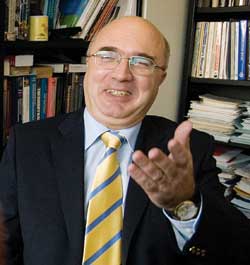The quantity of energy is quite strained

Radu Zmeureanu (Building, Civil and Environmental Engineering) is committed to building a sustainable future, and the sooner, the better.
Photo by Rob Maguire
In 1897-98, Paul Gaugin painted what for some is his ultimate masterpiece, D’où venons nous? Que sommes nous? Où allons nous? The brilliant oil on canvas, currently residing at the Museum of Fine Arts in Boston, depicts the stages of life from birth through maturity and death. For Radu Zmeureanu (Building, Civil and Environmental Engineering) the questions it asks are key to defining his own work.
Earlier this year, while on sabbatical at INSA-Lyon in France, Zmeureanu was invited to present at the Third European Research and Innovation Exhibition in Paris. He opened his talk with Gaugin’s painting.
“My presentation wasn’t so much scientific as a wake-up call,” he explained. “I wanted to emphasize that we are at a point in history where we are late in making our decisions. And while many people are now saying what needs to be said, key players are not listening.”
Like many others, Zmeureanu is concerned that we are collectively living beyond the means of the planet. His research therefore focuses on sustainability. As he pointed out, “Sustainability means different things to different people,” but as an engineer, he is interested in a scientific means of measuring it.
There are a number of sustainability indices: each requiring the commodification of some measure of environmental impact. The index espoused by the Kyoto Protocol uses CO2 as its commodity. Carbon dioxide credits can be exchanged between countries so that those who produce less of the gas, usually less developed nations, can benefit financially from the energy greed of more developed nations.
While Zmeureanu believes Kyoto is a step in the right direction, he said, “It is trying to solve a problem by touching on a symptom.” So in his own work, he is using exergy.
Exergy is a thermodynamic measure of how much work or power an energy source provides that incorporates a quantification of the quality of energy use compared to its application.
As he explained, “Electricity is seen as high quality energy.” From an exergy perspective, a problem occurs when the quality is degraded through uses “which can be covered by other energy sources more efficiently.” This means that in any system, the goal is to balance quality and quantity of energy input with quality and quantity of energy output.
For example, 90 per cent of electricity produced in Alberta is generated through the burning of fossil fuels. “Burning coal at 2000ºC to produce a room temperature of 20ºC makes no sense from an exergy perspective,” said Zmeureanu, because the equation is extremely unbalanced.
A 2005 compilation of international studies on exergy use in buildings concluded that they use only 15 to 20 per cent of the exergy generated, while “80 per cent is wasted.”
With this in mind, Zmeureanu and his team are focusing on research to minimize the waste. One of their projects is examining net-zero energy homes, another, exergy efficiency in ice rinks.
Zmeureanu thinks Canadians have a long way to go in balancing their equations. “I don’t use an air conditioner in the summer,” he said, but most people do. He pointed out that some day we may have to justify that luxury, as they do in France.
“New residential buildings in France are legally prohibited from using A/C,” he said. The Réglement Thermique of 2005 requires new designs to avoid the need for mechanical summer cooling. In order to get permission to use A/C, designers “must prove with computer simulations that there is no more elegant solution to the building’s cooling requirements.”